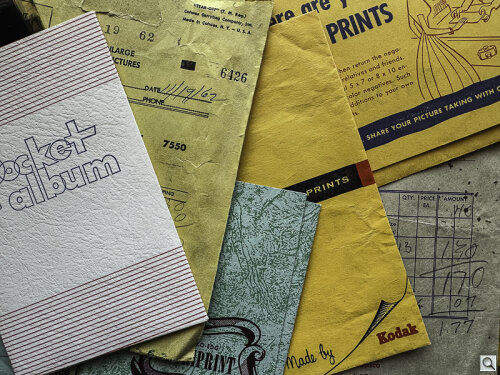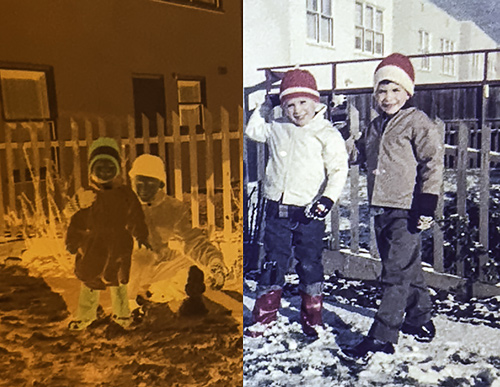Photo Corners headlinesarchivemikepasini.com
![]()
A S C R A P B O O K O F S O L U T I O N S F O R T H E P H O T O G R A P H E R
![]()
Enhancing the enjoyment of taking pictures with news that matters, features that entertain and images that delight. Published frequently.
Friday Slide Show: Childhood



12 July 2024
In the flurry to empty the family home, we packed six big cardboard boxes of photo albums to save from salvage. No, wait, seven. The seventh was a smaller box of what was tucked away from our last surviving grandparent's home.
We couldn't remember what was in it. Gram's photo albums. Her 50th anniversary party, albums of her daughter's family and her her son's family.
And a lot of negatives still in their drugstore envelopes.
We found the envelopes themselves amusing. Not just for their sub-dollar pricing and odd sizes but for their advice about taking pictures.
Because you don't need much imagination to guess a lot of "photographers" were pretty disappointed in their prints back then. And it wasn't the drugstore's fault.
It was the fault of those non-automatic cameras with parallax problems. "Unforgiving" should have been the brand name.
So film finishers gave advice like, "With simple cameras, keep at least 7 feet from the subject." Or, "For close-ups, be sure the camera lens, and not the viewfinder, is centered on the subject to avoid cutting off the subject." And, "Hold your breath when shooting to avoid camera movement."
Hold your breath, indeed.
Amusing as that was, was only half the story. The other half was the negatives, black-and-white and color, inside those envelopes.
We'd seen a few of the contact prints but here were the negatives. That we could scan and subject to modern digital post processing. Imagine!
What did they depict?
We used the trick described in our A Portable Negative Viewer to find out. Taking a snapshot with our phone and applying a Lightroom preset to convert black-and-white negatives to positives and color negatives to color images.
These were all images from our childhood. Before were a teen, as Mom and Dad grew their family from one rascal into four.
There we were at Grandma's or in our back yard or at Lake Tahoe for vacation. And, memorably, playing in a rare blanket of snow that fell in Daly City during 1962.
We're with siblings, cousins and older relatives long gone now. And we all are smiling and hugging and full of life. Parents and children, aunts and uncles, grandparents, cousins, everyone.
That was, of course, long ago.
Looking at these images, we can't help but reflect on what has happened since. Who has died, who has moved away, who no longer speaks to who, who rejects who.
What happens to us? How can some of us drift so far apart from where we once were?
In his book Off Mike, Michael Krasny recalls Israeli novelist Amos Oz explaining how:
There is no line between imagination and memory, just as there is none between tragedy and comedy. Everything we know of others, even those closest to us, is 20, maybe 30 percent data. All the rest is imagination, projection, wishful thinking, nightmare or a combination of all of them.
Which makes it easier to hold a grudge than to reach out or to write someone off rather than make peace.
Oz's point is that while we're sure we know the truth about someone, we hardly scratch the surface. When we think we clearly remember what happened, we don't have a clue. Just a fingernail of the long arm of the truth.
Once, though, long ago, we were in fact happy together. And, happily now, we have the pictures to prove it.
They do, all these years later, have something to say about what actually happened then. And that in itself can soften hard hearts.

